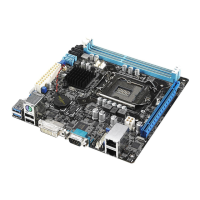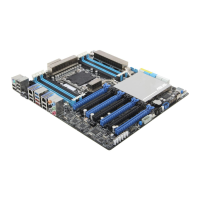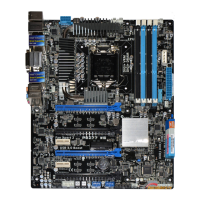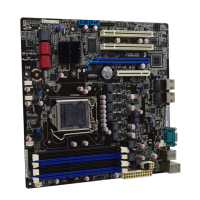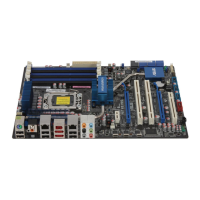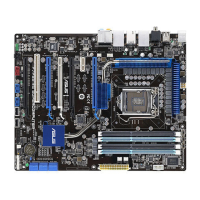Do you have a question about the Asus P9D WS and is the answer not in the manual?
Precautions for preventing electrical shock hazards during system operation and maintenance.
Guidelines for safe handling and installation of motherboard components and peripherals.
Describes the structure and content of the user manual for easy navigation.
Points to additional resources like ASUS websites for product updates and support.
Explains formatting conventions used in the manual for clarity.
A brief introduction and welcome message from ASUS for the motherboard.
Lists all items included in the motherboard package for user verification.
Highlights key technologies and unique capabilities of the P9D WS motherboard.
Details features tailored for workstation environments, enhancing reliability and performance.
Describes user-friendly and diagnostic features like Quick Gate, Diagnosis LED, and MemOK!.
Essential safety precautions and preparation steps before hardware installation.
Introduces the motherboard layout and key components for easy identification.
Step-by-step instructions for correctly installing the Central Processing Unit.
Detailed guide for installing Double Data Rate memory modules into the DIMM slots.
Instructions for securely mounting the motherboard within the PC chassis.
Guidance on installing various types of expansion cards into PCIe and PCI slots.
Identifies and explains the function of each connector on the motherboard's rear panel.
Walkthrough of the initial system power-on and POST process.
Explains the purpose and function of the UEFI BIOS in system configuration.
Instructions on how to enter and navigate the BIOS setup utility.
A simplified BIOS interface for basic system information and settings.
Comprehensive BIOS settings for experienced users, covering system configuration.
Settings for overclocking and tuning CPU and DRAM performance parameters.
Detailed options for optimizing memory performance through timing adjustments.
Utility for fine-tuning CPU and DRAM power delivery for efficiency and stability.
Adjusting voltage for CPU cores to manage performance and stability.
Accesses detailed settings for CPU, PCH, SATA, USB, and other system devices.
Settings related to CPU features like cores, threads, and power management.
Manages SATA device detection and mode settings (IDE, AHCI, RAID).
Settings for managing USB ports and features.
General information and procedures for updating the motherboard's BIOS.
Utility for recovering from corrupted BIOS files using support DVD or USB.
Notes on OS compatibility and general installation guidance.
How to use the included DVD to install drivers and software.
Overview of the integrated utility suite for system management and monitoring.
Explains the DIGI+ VRM utility for power control adjustments.
Details the Energy Processing Unit utility for power saving configurations.
Utility for optimizing and customizing fan speeds based on system temperature.
Technology to enhance USB 3.0 transfer speeds using UASP protocol.
Manages network bandwidth and prioritizes network traffic for applications.
Utility to view detailed motherboard, CPU, and memory information.
Utility for checking, saving, and scheduling BIOS updates via USB.
Feature for fast charging USB devices, even when the computer is off.
Explains the Realtek audio CODEC and its connection options.
Information on installing and configuring multiple ATI graphics cards.
Step-by-step guide for setting up dual ATI graphics cards.
How to activate the CrossFireX feature through the Catalyst Control Center.
Precautions for preventing electrical shock hazards during system operation and maintenance.
Guidelines for safe handling and installation of motherboard components and peripherals.
Describes the structure and content of the user manual for easy navigation.
Points to additional resources like ASUS websites for product updates and support.
Explains formatting conventions used in the manual for clarity.
A brief introduction and welcome message from ASUS for the motherboard.
Lists all items included in the motherboard package for user verification.
Highlights key technologies and unique capabilities of the P9D WS motherboard.
Details features tailored for workstation environments, enhancing reliability and performance.
Describes user-friendly and diagnostic features like Quick Gate, Diagnosis LED, and MemOK!.
Essential safety precautions and preparation steps before hardware installation.
Introduces the motherboard layout and key components for easy identification.
Step-by-step instructions for correctly installing the Central Processing Unit.
Detailed guide for installing Double Data Rate memory modules into the DIMM slots.
Instructions for securely mounting the motherboard within the PC chassis.
Guidance on installing various types of expansion cards into PCIe and PCI slots.
Identifies and explains the function of each connector on the motherboard's rear panel.
Walkthrough of the initial system power-on and POST process.
Explains the purpose and function of the UEFI BIOS in system configuration.
Instructions on how to enter and navigate the BIOS setup utility.
A simplified BIOS interface for basic system information and settings.
Comprehensive BIOS settings for experienced users, covering system configuration.
Settings for overclocking and tuning CPU and DRAM performance parameters.
Detailed options for optimizing memory performance through timing adjustments.
Utility for fine-tuning CPU and DRAM power delivery for efficiency and stability.
Adjusting voltage for CPU cores to manage performance and stability.
Accesses detailed settings for CPU, PCH, SATA, USB, and other system devices.
Settings related to CPU features like cores, threads, and power management.
Manages SATA device detection and mode settings (IDE, AHCI, RAID).
Settings for managing USB ports and features.
General information and procedures for updating the motherboard's BIOS.
Utility for recovering from corrupted BIOS files using support DVD or USB.
Notes on OS compatibility and general installation guidance.
How to use the included DVD to install drivers and software.
Overview of the integrated utility suite for system management and monitoring.
Explains the DIGI+ VRM utility for power control adjustments.
Details the Energy Processing Unit utility for power saving configurations.
Utility for optimizing and customizing fan speeds based on system temperature.
Technology to enhance USB 3.0 transfer speeds using UASP protocol.
Manages network bandwidth and prioritizes network traffic for applications.
Utility to view detailed motherboard, CPU, and memory information.
Utility for checking, saving, and scheduling BIOS updates via USB.
Feature for fast charging USB devices, even when the computer is off.
Explains the Realtek audio CODEC and its connection options.
Information on installing and configuring multiple ATI graphics cards.
Step-by-step guide for setting up dual ATI graphics cards.
How to activate the CrossFireX feature through the Catalyst Control Center.
| Microphone in | Yes |
|---|---|
| PS/2 ports quantity | 1 |
| USB 2.0 ports quantity | 4 |
| Ethernet LAN (RJ-45) ports | 2 |
| VGA (D-Sub) ports quantity | 0 |
| USB 3.2 Gen 1 (3.1 Gen 1) Type-A ports quantity | 1, 2 |
| USB 2.0 connectors | 3 |
| Number of SATA III connectors | 6 |
| Supported DIMM module capacities | 1GB, 2GB, 4GB, 8GB |
| Memory channels | Dual-channel |
| Supported memory types | DDR3-SDRAM |
| Maximum internal memory | 32 GB |
| Supported memory clock speeds | 1333, 1600 MHz |
| BIOS type | EFI AMI |
| ACPI version | 2.0a |
| BIOS memory size | 64 Mbit |
| RAID levels | 0, 1, 5, 10 |
| Supported storage drive interfaces | SATA III |
| Wi-Fi | No |
| LAN controller | Intel I210 |
| Cables included | SATA |
| Processor socket | LGA 1150 (Socket H3) |
| Intel Xeon series | E3-1200 |
| Processor manufacturer | Intel |
| Processor number of cores supported | 2, 4 |
| Parallel processing technology support | 4-Way CrossFireX |
| Component for | Workstation |
| Motherboard chipset | Intel® C226 |
| Audio output channels | 7.1 channels |
| Motherboard form factor | ATX |
